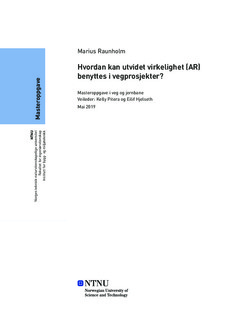| dc.contributor.advisor | Piteira, Kelly | |
| dc.contributor.advisor | Hjelseth, Eilif | |
| dc.contributor.author | Raunholm, Marius | |
| dc.date.accessioned | 2020-03-05T15:00:33Z | |
| dc.date.available | 2020-03-05T15:00:33Z | |
| dc.date.issued | 2019 | |
| dc.identifier.uri | http://hdl.handle.net/11250/2645609 | |
| dc.description.abstract | Bruk av 3D-modeller, fagmodeller og BIM i samferdselsbransjen har økt voldsomt de seneste år, og det er nå en selvfølge å benytte seg av disse planleggingsmetodene. Dette har medført en redusering av prosjekteringsfeil, endringsordre og planleggingstiden. Teknologiutviklingen går raskt, og den bygger på eksisterende teknologi som er bevist at fungerer. Det er her utvidet virkelighet (AR) for vegprosjekter har dukket opp, som er et biprodukt av BIM og 3D-modeller. Selv om AR har eksistert i noen år, så er det først de siste 2-3 årene det har blitt benyttet for samferdsel. Det finnes lite forskning på akkurat dette emnet, og det er en av årsakene for denne masteroppgaven, nemlig å undersøke hva potensialet til AR for vegprosjekter er. Det er tatt for seg regulering- og byggeplanfasen for et vegprosjekt, og sett på mulighetene i disse fasene.
Statens vegvesen har en virksomhetsstrategi som tilsier at man skal bruke BIM for å utvikle nye metoder og tekniske standarder. Man bør derfor se om bruk av utvidet virkelighet (AR) kan bidra til effektivisering og øke medvirkningen i planleggingen og bygging av vegprosjekter.
Det er benyttet en kvalitativ forskningsmetode i denne masteroppgaven, og det er utført tester av 2 ulike AR-verktøy, både for å generere innhold til intervju, men også for egen erfaring og utvikling. Intervjuet ble utført for å skaffe nok datagrunnlag for diskusjon.
Det er formulert tre forskningsspørsmål som skal besvare denne problemstillingen.
• Hvilket potensiale har AR, hva kan det tilføre vegprosjekter?
• Hvilke utfordringer er det ved bruk av utvidet virkelighet (AR)?
• Hvilke tiltak må på plass for å ha best nytte av AR?
Testresultatene i denne oppgaven har resultert i en konklusjon om at dagens AR-verktøy fungerer til dels, men det er store utfordringer med nøyaktighet og brukervennlighet på disse verktøyene. Resultat fra intervjuene viser at det er stort potensiale ved bruk av AR, der reguleringsplanfasen har stor mulighet for økt medvirkning, forståelse av prosjektet og en kostnadsreduksjon i planleggingen.
I byggefasen er det potensiale for å redusere byggefeil, oppdage kollisjoner mellom 3D-fagmodeller og den virkelige verden samt logistikk planlegging. Nøyaktighet og brukervennlighet er også en stor utfordring for AR-verktøy i denne fasen.
Tiltakene som må på plass for å ha best nytte av utvidet virkelighet i vegprosjekter er at verktøyene som skal brukes, må velges ut fra den nøyaktigheten og brukervennligheten man behøver. Til en reguleringsplanfase trenger man ikke like høy nøyaktighet, men brukervennligheten må være høy. For byggefasen er nøyaktighet et viktig premiss. Brukervennligheten behøver nødvendigvis ikke være så høy, da det er teknisk kompetente fagpersoner i denne fasen. | |
| dc.description.abstract | The use of 3D-models, discipline models and BIM in the transport industry has increased considerably in the recent year, and is now the industry standard in the planning of roads. This has resulted in a reduction of design error, the change orders and planning time. The technology development is a quick tempo industry, and it builds on existing technology that has proven to be successful. This is where augmented reality (AR) in road planning has appeared. Even thou AR has been around for a while, it is only in the last couple of year AR has been used for road projects. There is very little research on this specific topic, which is one of the reasons for this master thesis, to examine what the potential for AR in the transport industry is. The regulation- and building phase are used as the basis for this thesis.
The Norwegian public roads administration has a business strategy that states that we “shall use BIM to develop new methods and technical standards”, and therefore we should see if augmented reality (AR) can help to streamline and increase the complicity in the regulation and building phase in the transport industry.
For this master thesis, a qualitative research method was used. Two tests of different AR-tools was also completed, to generate content for the interview, but also for my own experience and learning. Interview was the method to get the data basis that the discussion required.
There are three research questions to answer this issue.
• What potential does augmented reality (AR) have, what can AR add to road projects?
• What challenges does augmented reality have?
• What measures are needed to have the best use of augmented reality?
The test results in this thesis as resulted in a conclusion that the AR-tools that exist today, for road projects, only work partially. There are significant challenges regarding the accuracy and user-friendliness of these tools. The result from the interviews says that is a big potential in the use of AR. The regulation planning has potential in the increase of complicity, understanding of the project and to reduce costs in the planning phase. While the building phase has the potential to reduce building errors, discover possible collisions between the discipline models and the real world, and logistics planning. Accuracy and user-friendliness is also a big challenge in this phase.
The measures that are needed to make the best use of augmented reality in road projects are to make sure that the tools that are used, have the accuracy and user-friendliness that are required. For the regulation phase, you don’t need the same accuracy as the building phase, but the user-friendliness has to be high. And in the building phase, the user-friendliness doesn’t have to be that high, since there is a lot of technical competent people involved. | |
| dc.language | nob | |
| dc.publisher | NTNU | |
| dc.title | Hvordan kan utvidet virkelighet (AR) benyttes i vegprosjekter? | |
| dc.type | Master thesis | |
